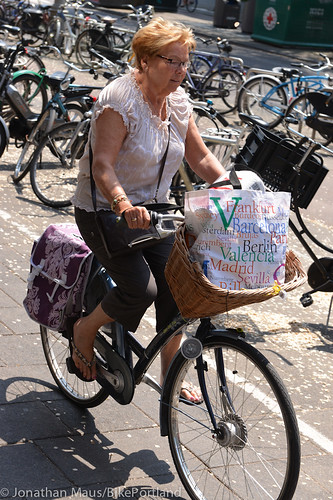
The ‘Age Friendly Portland Advisory Council’ (coordinated by the non-profit Elders in Action) has just launched a new website to spread awareness of the action plan they developed last year. In October 2013, Portland City Council adopted the Action Plan for an Age Friendly Portland (PDF) which outlines how Portland can help its older residents ease into their later years while enjoying active and socially vibrant lifestyles.
It’s not often talked about along with bicycling’s myriad other benefits, but cities where bicycling is easy and viable will enjoy a considerable head start in their efforts to be age friendly. We took a closer look at the action plan and were pleased to see that its authors seem to understand and embrace this concept.
In the plan’s eight different action areas, several of them deal with issues that relate to bicycle access.
In the Transportation action area, the plan makes it clear that Portland must make it easy for seniors to use bicycles and other forms of non-car transportation. The plan even directly addresses active transportation.
Here’s “Action Item 2” in the Transportation action area (emphasis mine):
Action Item 2 – Active Transportation: Active transportation2 promotes active aging and is a fundamental aspect of an age-friendly city. Policies must be developed and implemented that result in environments are not automobile-centric, but rather, are developed in a manner that facilitates physical activity and convenient local access. Transportation infrastructure must be built to human scale, developed with universal design principles (above and beyond required minimum accessibility standards), and must ultimately lead to safe, healthy, efficient, and well-maintained systems.
The active transportation/age friendly link should be obvious; but we see other parts of this plan where bicycling can play a role.
In the “Respect and Social Inclusion” section, the plan’s authors write about the importance of reducing social isolation. “Finding ways to include aging Portlanders into activities and communities is critically important, as is stemming social isolation that has many deleterious effects.” One great thing about bicycling is that — similar to walking — it encourages much more social interaction than driving. Older citizens who get out into the neighborhood and run errands by bike will undoubtedly find themselves having more conversations with neighbors and friends. They’ll also feel more connected to, and invested in, their community.
With so many young Americans afraid to bike themselves, it’s likely that many people think cycling by senior citizens is simply out of the question. But as we saw in a recent trip to the Netherlands and Copenhagen, when streets and services are designed specifically with cycling in mind, it becomes an easy, cheap, and extremely beneficial form of transportation.
By 2030, the population of older adults in the United States is expected to double. And with Portland already being a magnet for climate refugees and other groups seeking the high quality of life this region provides, planning for an older population will become even more important. If our leaders are smart, they’ll heed the recommendations in this plan and make bicycling a key component of our age friendly future.







